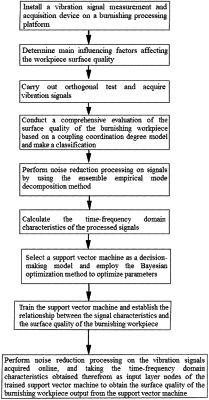| CPC G01N 29/12 (2013.01) [G06N 20/10 (2019.01)] | 5 Claims |

|
1. A method for predicting surface quality of a burnishing workpiece, comprising the following steps:
step 1: installing a vibration signal measurement and acquisition device on a burnishing processing platform;
step 2: determining main influencing factors affecting a surface quality of a burnishing workpiece and the number of each influencing factor, designing orthogonal tests with different combinations of influencing factors and levels, performing burnishing tests and acquiring vibration signals, carrying out a comprehensive evaluation of the surface quality of the burnishing workpiece based on a coupling coordination degree model, and classifying the burnishing workpiece according to the comprehensive evaluation results;
step 3: dividing vibration signals in different scales by using an ensemble empirical mode decomposition method to achieve noise reduction; and selecting component signals without noise interference for superposition, and calculating the time-frequency domain characteristics of superposed signals;
step 4: selecting a support vector machine as a decision-making model of the workpiece surface quality, selecting a radial basis function as a kernel function, determining an optimal selection range of penalty parameters and kernel function parameters, and optimizing these two parameters based on Bayesian optimization method to obtain a best value;
step 5: taking the time-frequency domain characteristics of the signals obtained in the step 3 as input layer nodes of the support vector machine, taking the surface quality classification results obtained in the step 2 as output layer nodes thereof to train the support vector machine and obtain a trained support vector machine, so that a relationship between the signal characteristics and the surface quality of the burnishing workpiece is established; and
step 6: carrying out step 3 for the vibration signals collected online in the burnishing test, and taking the time-frequency domain characteristics finally obtained as input layer nodes of the trained support vector machine to obtain the surface quality of the burnishing workpiece output from the support vector machine,
wherein in the step 2, a comprehensive evaluation of the surface quality index of the burnishing workpiece is conducted based on a coupling coordination degree model, and the burnishing workpiece is configured to be classified according to the comprehensive evaluation results, with specific steps as follows:
(1) taking a surface roughness increase and a hardness increase as analysis items of the coupling coordination degree model;
(2) setting weights of the surface roughness increase and the hardness increase, performing interval processing on data of the analysis items, and ensuring the data after the processing fall between 0 and 1;
(3) calculating a coupling degree, a coordination index and a coupling coordination degree, and classifying the coupling coordination degree in combination with classification criteria for the coupling coordination degree grading; and
(4) classifying the burnishing workpiece according to the coupling coordination degree, when the coupling coordination degree is maladjustment, the surface quality of the burnishing workpiece is poor, otherwise, the surface quality of the burnishing workpiece is excellent;
wherein the step 3 is implemented through the following sub-steps:
(1) adding small-amplitude white noise signals to the vibration signals several times, and adding random seeds to maintain consistency of decomposition results:
(2) dividing the vibration signals in time scale after multiple additions of white noise by using the ensemble empirical mode decomposition method to obtain component signals;
(3) plotting a power spectrum of each component signal and comparing a shape of the power spectrum of each component signal;
(4) selecting the power spectrum of each component signal with a smooth shape, that is, the component signals without noise interference, and superimposing these signals to obtain superimposed signals; and
(5) identifying power spectral density, kurtosis and form factor as the time-frequency domain characteristics of the superimposed signals, and estimating the power spectral density of the superimposed signals based on a maximum entropy method.
|